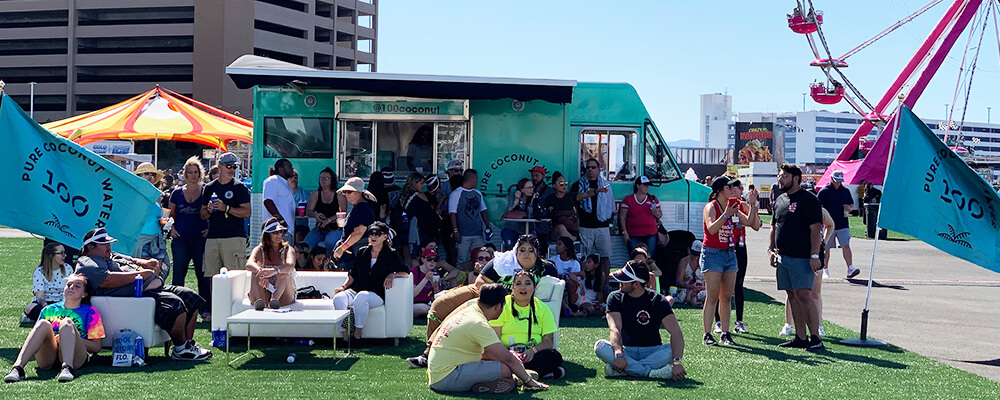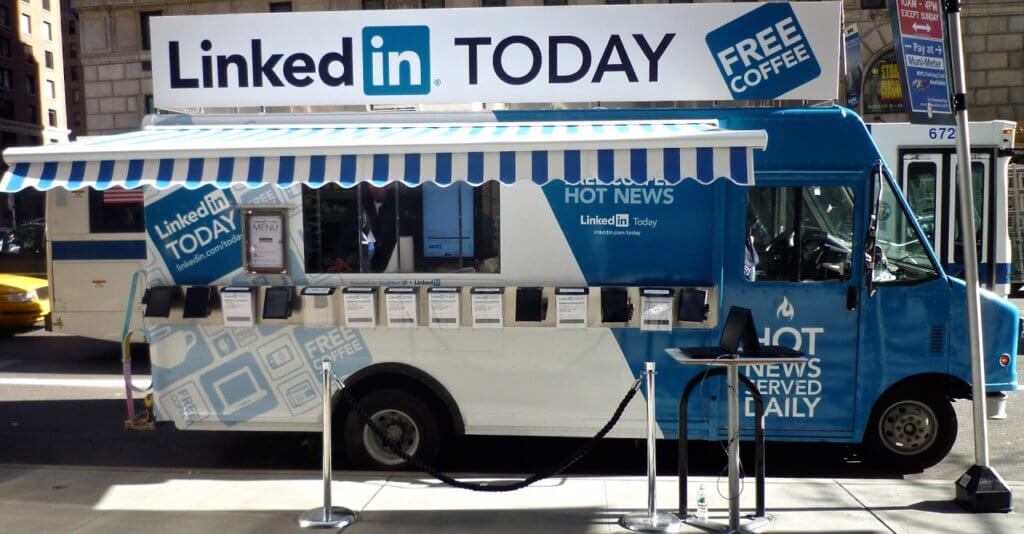
Brands are always trying to keep up with the emerging trends that are driving consumer purchase behaviors. A lot of time and effort goes into creating new marketing strategies that will help brands stand out and get people talking on social media platforms. In recent years, it has become significantly more challenging to drive consumers into a brick-and-mortar store without the help of advertising. It is becoming a necessity for brands to incorporate some form of personalized interaction or an added experience in order to increase sales and brand loyalty. Advertisers are realizing the value in implementing experiential marketing by using mediums such as promo trucks for their campaigns. A promo truck is a promotional vehicle used by a company to promote its brand and services in any location. It has the ability to communicate with passersby through its design elements and interactive model. Add food and beverages to its offering and it becomes a food truck advertising campaign that can stimulate an exciting multi-sensory experience.
Food trucks are a type of promo truck that serves the purpose of selling, exhibiting, informing, and even offering home deliveries. Food trucks typically have a kitchen that can prepare fresh and warm meals or a bar that offers beverages. The original concept of a food truck was to cater to the changing consumer preferences for unique, gourmet cuisine at affordable prices that could move from place to place. The food truck industry has expanded over the past five years and is now one of the best performing segments in the broader food service sector. A food truck can be used in more ways than the name suggests. While it can surely be an ideal medium for any food and beverage business to sample its offerings, it can be utilized for so much more than that. The food truck industry has broadened its purposes so that it is now also used by both the brand advertising on the medium and the catering service entrusted by the brand, so everybody wins! Industries such as fashion, entertainment, technology, and finance have also hopped on the bandwagon to benefit from what food trucks have to offer. They are becoming an ideal solution for brands that are looking for an out-of-the-box idea to launch a new product, test out a new market, raise money for a cause, or get trending on social media. Whether brands are making use of the advertising space on an existing food truck or are transforming their own into a branded experiential ad, both are reaping the rewards. Let’s take a look at some of the benefits of branded food truck advertising along with great examples of brands who incorporated them in their experiential marketing campaigns.
Benefits of Food Truck Advertising
Creativity
Food trucks are known for their creative take on traditional cuisines. By adopting the same creative aspect that food trucks offer, brands are also putting their own innovative twist on advertising. Food trucks are using creative custom-wrapping, sampling, giveaways, and retail promotions to draw the public’s attention towards them. This is a remarkable opportunity for companies to build their brand using creativity to create buzz about their products.

User Participation and Engagement
When brands use experiential marketing in the form of food truck advertising, they are asking their consumers to participate in the advertisement. A brand’s ultimate goal with this type of advertising is to get their products in the hands of consumers and from then on, form a connection. When bypassers partake in the experience, the strategy becomes one that combines brand experience with product endorsement. This is especially true for tech companies who can leverage their technology used in the makings of the ad to be the same product being marketed. Combine a delicious treat in the mix, and the campaign is a huge success. This is exactly what tech Giant Google did to promote their new photo app, Google Photos.

Google used a cupcake food truck in Austin, Texas to promote their unique feature of finding photos in an instant with the Google photos app. They asked customers to find their best photo of a certain object written on the board in exchange for a cupcake using their ‘Pay with a Photo’ method. Additionally, the ad included a section encouraging participants to share the taste of victory on social media using the hashtag #PayWithaPhoto. The campaign was successful at creating excitement amongst participants as they scrambled as fast as they could to find a particular photo in order to get their treat, while simultaneously building a connection with a memorable experience.
Mobility
Using a branded mobile vehicle allows for a higher amount of exposure than a stationary billboard. When brands invest time and money into their advertisements, they want to gain its maximum reach potential. Being mobile helps brands reach busy areas without the hindrance of high cost locations. Before a campaign is implemented, advertisers do a lot of scouting to learn the key areas of each market in order to achieve a high number of impressions and engagements. A mobile food truck does not have to be restricted to one area, it can travel from one state to another, stopping in areas based on specific audience demographics and interests. By touring across the country, brands have boundless opportunities to increase the brand’s reach and make a memorable impact.

Direct Interaction
Interacting with consumers is not always an easy task, sometimes the messaging of an ad can be misinterpreted. Serving consumers in a food truck can provide companies an up-close and personal interaction that no other form of advertisement can. Moreover, the most exciting interaction that consumers can experience is when a public figure or celebrity acts as a brand ambassador for the brand, creating a surprise factor, a massive crowd following, and viral media content. Not to mention the opportunity for fans to meet their favorite celebrities creating a memorable experience they will never forget. An example of a celebrity that opted for a food truck to promote her new album, ‘Food’, and culinary line was singer Kelis. She personally drove around in a customized truck serving her signature soul food while interacting directly with her fans.
Another example of celebrities that used a food truck to create buzz were comedian Kevin Hart and rapper The Ice Cube, when they took over Nova’s Fitzy and Wippa’s ice-cream truck to promote their new movie, ‘Ride Along 2’.
Trending on Social Media
A food truck promotion has the ability to increase a brand’s reach on social media because of its experiential marketing abilities that propel people to share it with their family and friends. Brands are constantly looking for ways to become trending on social media and a successful way of doing so is by creating a fun and engaging campaign that consumers want to be a part of. Some trending hashtags on social media consist of national calendar days such as, “National Pizza Day” and, “National Croissant Day”. Calvin Klein decided to create a campaign that celebrates “National Underwear Day”, using a branded food truck.

Calvin Klein teamed up with Food Truck Promotions and Van Leeuewen Artisan Ice Cream to create their own unique celebration for the National Underwear Day Worldwide Movement to promote body image and confidence. On a hot summer day in New York City, they handed out hundreds of free limited edition MyCalvins underwear embroidered with an ice cream cone that matched the color of the flavor they ordered. The #MyCalvins and #NationalUnderwearDay hashtags went viral as people shared their photos of the event on social media platforms. The brand found a clever way to associate itself with the National Day, making Calvin Klein a representative of the movement.
Product Launch and Brand Perception
Using a branded food truck is a great way to launch a new product or test out the market because of its ability to instantaneously measure the public’s reaction. The way your brand is perceived by consumers can determine the future of the company. A food truck promotion gives brands the opportunity to build on that perception or change it if need be. By giving out free food and samples while offering a fun experience, consumers can see a brand in a whole new light. For brands, it provides them a chance to test out their new services or products using a low cost advertising medium, minimizing the risk factor, and gaining positive brand perception.

LinkedIn launched their new product, LinkedIn Today using a branded food truck styled to look like their very own Mobile News Cafe that served hot brewed coffee. The company’s goal was to increase awareness for the new product by introducing it as a daily indispensable resource for business professionals, just as coffee is. The clever comparison was worded as, “Hot News Served Daily”, and, “Freshly Brewed News and Insights”, via LinkedIn Today. The food truck toured the downtown areas of San Francisco and New York, targeting business professionals by offering them a cup of coffee and the daily news – both essential items for their daily routine. The campaign garnered around 1 million impressions and visitors spent an average of 4 minutes with the product while sipping their coffee.
The Bottom Line
Branded food trucks are an innovative way of reaching consumers using experiential advertising methods to stand out among the competition. Like any experience, an emotional reaction is triggered. When that happens, a relationship between the brand and the consumer is formed, which can result in brand loyalty. Adding a form of service or product offering into a campaign can immediately increase the engagement rate. When the offering incorporates food and drinks, bypassers are sure to stop by. Even if they aren’t necessarily interested in the product that’s being sold, the publicity it creates is already a win for the brand. After all, food brings people together.


